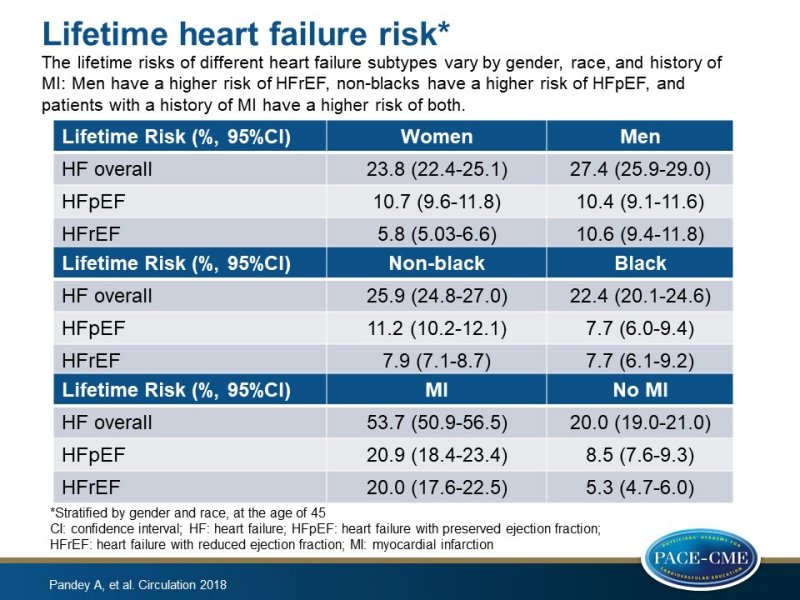ReachMD
Be part of the knowledge.™Lifetime risks of HF subtypes differ based on gender, race and previous MI
Background
Lifetime risk estimates provide a comprehensive assessment of the population-level disease burden, while accounting for other competing risks such as mortality [1]. The overall lifetime risk estimates for HF are 20%-46% [2,3], but the lifetime risk estimates for HF with preserved ejection fraction (HFpEF) and HF with reduced ejection fraction (HFrEF) have not been studied.
In this study, the lifetime risks of HFrEF (LVEF <45%)and HFpEF (LVEF ≥45%) were calculated at selected ages, stratified by race, gender, and history of antecedent MI, using data from 2 large prospective cohort studies: the Cardiovascular Health Study (CHS) and the Multiethnic Study of Atherosclerosis (MESA) [4,5]. For the present analysis, all participants from the 2 studies were included, who were older than 45 years of age without prevalent HF at baseline.
The main participant characteristics of interest for the lifetime risk estimation were: age, gender, race, prevalent MI at baseline, and incident MI on follow-up antecedent to HF. The primary outcomes of interest were the incidence of overall HF and its subtypes, HFrEF and HFpEF.
Main results
- Overall, 12,417 participants (44.8% men, 22.2% blacks) were included in the analysis. 2,178 incident HF events were observed over a median follow-up of 11.6 years. 726 were incident HFpEF events, and 561 were incident HFrEF events (rest with HF and missing EF).
- The lifetime risk of overall HF was higher in men compared with women regardless of the index age. For example, at the age of 45, the risk was 27.4% (95%CI: 25.9-29.0) for men and 23.8 % (95%CI: 22.4-25.1) for women.
- The lifetime risk of HFrEF was up to 1.8-fold higher in men as compared with women (at the age of 45: 10.6%; 95%CI: 9.4-11.8 vs. 5.8%; 95%CI: 5.03-6.6), but the lifetime risk of HFpEF was similar for men and women.
- The lifetime risk of overall HF was higher in non-blacks compared with blacks regardless of the index age. For example, at the age of 45, the risk was 25.9% (95%CI: 24.8-27.0) for non-blacks and 22.4% (95%CI: 20.1-24.6) for blacks.
- The lifetime risk of HFpEF was approximately 1.5 fold higher in non-blacks as compared with blacks (at the age of 45: 11.2%; 95%CI: 10.2-12.1 vs. 7.7%; 95%CI: 6.0-9.4), but the lifetime risk of HFrEF was similar in blacks and non-blacks.
- The lifetime risks of HFpEF and HFrEF at index age 45 through 90 were 2.5 to 4-fold higher in participants with antecedent MI compared to those without antecedent MI (HFpEF: 20.9%; 95%CI: 18.4-23.4 vs. 8.5%; 95%CI: 7.6-9.3; HFrEF: 20.0%; 95%CI: 17.6-22.5 vs. 5.3%; 95%CI: 4.7-6.0).
Conclusion
The lifetime risks for HFpEF and HFrEF vary by gender, race, and history of antecedent MI: men have a higher risk of HFrEF compared with women, non-blacks have a higher risk of HFpEF compared with blacks, and MI patients have a higher risk of both HFpEF and HFrEF compared with individuals without MI. These findings may be helpful to develop more individualized prevention strategies.

References
1. Berry JD, Dyer A, Cai X, et al. Lifetime risks of cardiovascular disease. N Engl J Med. 2012;366:321-9.
2. Huffman MD, Berry JD, Ning H, et al. Lifetime risk for heart failure among white and black Americans: cardiovascular lifetime risk pooling project. J Am Coll Cardiol. 2013;61:1510-7.
3. Lloyd-Jones DM, Larson MG, Leip EP, et al. Lifetime risk for developing
congestive heart failure: the Framingham Heart Study. Circulation. 2002;106:3068-72.
4. Bild DE, Bluemke DA, Burke GL, et al. Multi-Ethnic Study of Atherosclerosis: objectives and design. Am J Epidemiol.2002;156:871-81.
5. Fried LP, Borhani NO, Enright P, et al. The Cardiovascular Health Study: design and rationale. Ann Epidemiol. 1991;1:263-76.
Facebook Comments